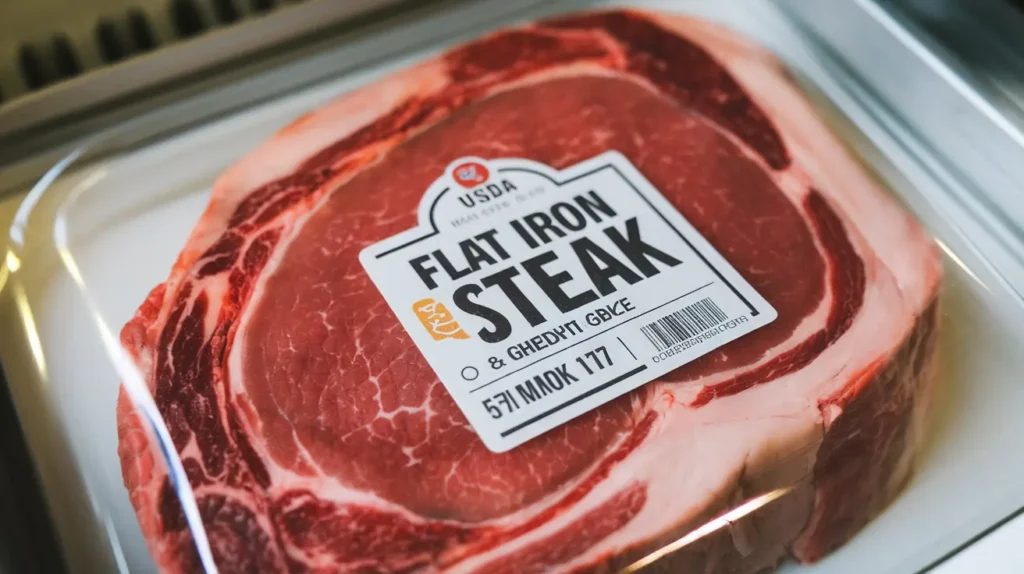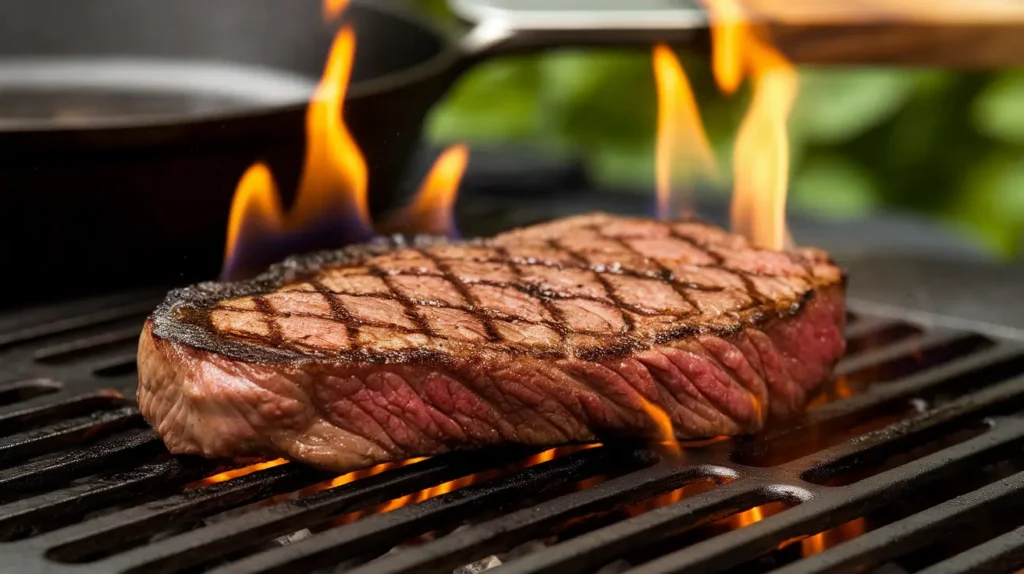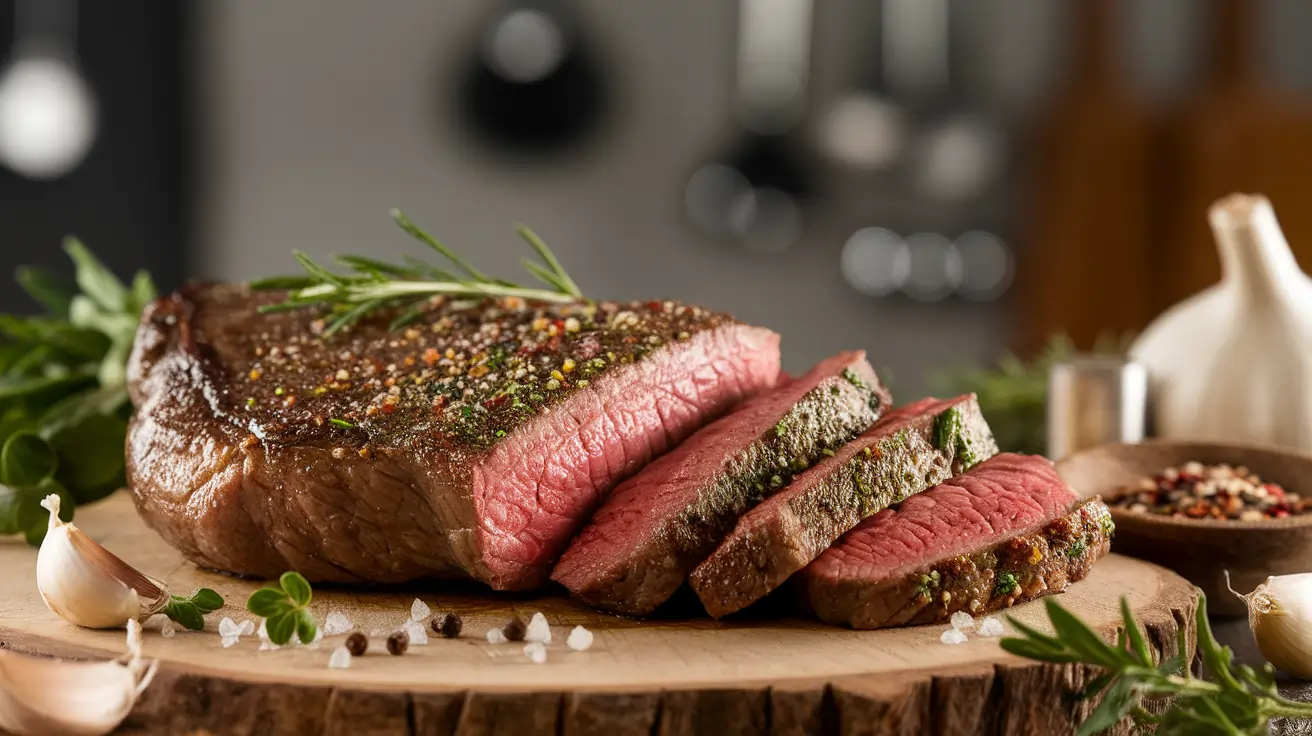This flat iron steak guide will help you decode confusing labels and teach you how to select the best cut for your next meal. When it comes to picking the perfect steak, the label can feel like a mystery novel. Ever wondered what all those words and numbers mean on a beef loin flat iron steak label? 🤔 Don’t worry, you’re not alone! Whether you’re a seasoned chef or just someone who loves a good steak night, decoding that label can help you make better choices and get the most bang for your buck. Let’s dive into this flavorful journey together!
Table of Contents
What Is a Flat Iron Steak Label?
Origins and Characteristics
The flat iron steak comes from the beef loin, specifically the shoulder area, also known as the chuck. It’s known for its exceptional tenderness (second only to filet mignon!) and rich, beefy flavor. Think of it as the steak equivalent of that friend who’s always dependable—great in all situations, whether grilled, pan-seared, or marinated.
Why is it called “flat iron”? Well, its name comes from its shape—it resembles the flat side of an old-school iron. Pretty cool, right?
Why It’s a Popular Choice for Steak Lovers
Flat iron steak has skyrocketed in popularity for a few reasons:
- Affordable Luxury: You get restaurant-quality tenderness without the premium price tag.
- Versatility: It’s perfect for everything from fancy dinners to casual BBQs.
- Quick Cooking: Unlike some cuts, it doesn’t require hours of marinating or slow cooking.
It’s like the Swiss Army knife of steaks—versatile, reliable, and always satisfying. 🥩
Decoding the Flat Iron Steak Label

A flat iron steak guide wouldn’t be complete without a breakdown of what all those terms on the label actually mean.
Key Terms to Look For
When you pick up a package, these are the terms you should pay attention to:
- Beef Loin: This tells you the cut comes from the back of the cow, a region known for tender and flavorful steaks.
- Flat Iron: Indicates the specific muscle, prized for its tenderness.
- Angus or Wagyu: These terms can hint at the breed, which might affect flavor and marbling.
USDA Grading: What It Means for Quality
Ever seen terms like “Prime,” “Choice,” or “Select” on the label? These are USDA quality grades:
- Prime: The crème de la crème! Packed with marbling for a juicy and tender experience. Perfect for special occasions. ✨
- Choice: Great quality with slightly less marbling than Prime. Ideal for everyday meals.
- Select: Leaner with less marbling, good if you’re watching your fat intake but still crave steak.
“Marbling” is just a fancy word for the white streaks of fat in the meat that make it juicy and flavorful.
Understanding Packaging and Expiration Dates
Don’t skip the fine print on the package. Look for:
- Sell-By Date: Tells you how fresh the steak is.
- Vacuum-Sealed Packaging: This keeps the steak fresh longer by reducing exposure to air.
- Weight: Helps you plan portions—about 6–8 oz per person is usually perfect.
Common Issues with Flat Iron Steak Labels
Even though flat iron steak is amazing, there are a few pitfalls you need to watch out for. Let’s break them down.
Misleading Labels: How to Spot Them
Some labels might use fancy-sounding terms to trick you into paying more. For instance, words like “natural” or “grass-fed” sound great, but they don’t always mean what you think. Natural only means the meat doesn’t have artificial additives—it doesn’t guarantee better quality. Always check for USDA certifications for clarity.
Recognizing Low-Quality Cuts
Ever had a steak that was all gristle and no goodness? That’s what happens when you get a cut that wasn’t properly trimmed. Look for steaks with even marbling and avoid ones with large, tough-looking sections of fat or connective tissue.
Overpaying for Non-Premium Cuts
Sure, the flat iron steak is great, but don’t let marketing gimmicks convince you to overpay. If you see terms like “limited edition” or “premium reserve” with no clear grading, you might be shelling out extra cash for nothing special.
Pro Tip: Stick to USDA-graded steaks and look for transparent labels that list breed, grade, and origin.
Solutions to Label Confusion
Let’s turn those label woes into wins! Here’s how you can confidently choose your steak every time.
Tips for Reading Labels Correctly
- Start with the Basics: Focus on the cut (flat iron), grade (Prime/Choice), and weight.
- Ignore Fluff Words: If it’s not USDA-certified, take claims like “all-natural” with a grain of salt.
- Compare Prices: Check different brands to ensure you’re getting value for money.
How to Identify High-Quality Beef at a Glance
- Look for even marbling across the steak.
- The color should be bright red, not brownish.
- A slight sheen indicates freshness.
Table: Beef Loin Flat Iron Steak Nutritional Facts (Per 6 oz Serving)
| Nutrient | Quantity |
|---|---|
| Calories | 310 |
| Protein | 23g |
| Total Fat | 21g |
| Saturated Fat | 9g |
| Cholesterol | 80mg |
| Iron | 2.4mg |
| Zinc | 6.2mg |
Flat iron steak is not just tasty—it’s packed with protein and essential nutrients like iron and zinc to keep you fueled and energized. 💪
Cooking Tips for Flat Iron Steak

Cooking flat iron steak isn’t rocket science—it’s more like an art form. Whether you’re grilling, searing, or using sous vide, this flat iron steak guide has the tips you need for perfect results every time. The beauty of this cut is its versatility, so whether you’re a grill master or a beginner with a frying pan, you can create something truly mouthwatering. Let’s break it down step by step. 🔥
Best Preparation Techniques
Before you even think about turning on the heat, preparation is key. Here’s what you need to do:
- Bring It to Room Temperature: Take the steak out of the fridge about 30 minutes before cooking. This helps it cook evenly.
- Pat It Dry: Use a paper towel to remove excess moisture. A dry surface ensures a beautiful sear.
- Season Generously: Sprinkle both sides with salt and pepper. Want to take it up a notch? Add garlic powder, paprika, or even a pinch of cayenne for some heat.
Block Quote: “A well-seasoned steak is like a good story—layered, balanced, and unforgettable.”
Marinating and Seasoning Tips
Flat iron steak is tender enough that it doesn’t need a marinade, but if you’re looking to boost the flavor, go for it! Try a simple marinade with:
- Olive oil: Adds richness.
- Soy sauce: For umami depth.
- Garlic: Because, let’s be honest, garlic makes everything better.
- Lemon juice: A little acid helps break down fibers for extra tenderness.
Let it sit in the marinade for 1–2 hours (no more than that, or the texture might suffer).
Cooking Methods: Grilling, Pan-Seared, and Sous Vide
Here’s where the magic happens. Depending on your equipment and vibe, you’ve got options.
Grilling: For That Smoky Flavor
- Preheat your grill to medium-high heat.
- Place the steak on the grill and cook for 4–5 minutes per side for medium-rare.
- Let it rest for 5 minutes before slicing.
Grilling gives you those Instagram-worthy grill marks and a smoky kick.
Pan-Seared: Perfect for Indoors
- Heat a cast-iron skillet over high heat. Add a bit of oil.
- Sear the steak for 3–4 minutes on each side.
- Optional: Add a pat of butter and fresh herbs like thyme during the last minute for a baste.
Sous Vide: For Precision Cooking
- Seal the steak in a vacuum bag with your favorite seasonings.
- Cook in a sous vide machine at 130°F for 1–2 hours.
- Finish with a quick sear in a hot pan for that crispy crust.
Nutritional Value of Beef Loin Flat Iron Steak
Flat iron steak isn’t just delicious—it’s also packed with nutrients that your body will thank you for. 💪 Let’s break down its health benefits.
Protein and Essential Nutrients
One serving (about 6 oz) of flat iron steak provides:
- Protein: 23g, which is fantastic for muscle growth and repair.
- Iron: Helps transport oxygen in your blood, reducing fatigue.
- Zinc: Supports your immune system and helps with healing.
It’s basically a nutritional powerhouse wrapped in juicy, tender goodness. Plus, it’s naturally low in carbs, making it a great option for keto and low-carb diets.
How It Fits Into a Balanced Diet
Worried about fat content? While flat iron steak does have a higher fat content compared to lean cuts, it’s mostly healthy fats that can be part of a balanced diet. Pair it with leafy greens, roasted veggies, or a light salad to balance the richness. 🥗
Pairing Suggestions for Flat Iron Steak
One of the biggest challenges a flat iron steak guide can solve is understanding which labels indicate quality and which are just marketing. No steak is an island—it’s all about the company it keeps. Here are some pairing ideas to make your meal unforgettable.
Ideal Side Dishes for Flat Iron Steak
- Garlic Mashed Potatoes: Creamy and comforting.
- Grilled Asparagus: Adds a fresh crunch.
- Sweet Potato Fries: A sweet and savory contrast.
Block Quote: “A good steak without the right sides is like a movie without popcorn—still good, but not the full experience.”
Beverage Pairing Recommendations
The right drink can elevate your steak to a whole new level. Try these:
- Red Wine: A bold Cabernet Sauvignon complements the richness perfectly.
- Craft Beer: A malty stout or amber ale pairs wonderfully.
- Iced Tea or Lemonade: Great non-alcoholic options for casual meals.
Table: Quick Reference for Cooking Temperatures
| Doneness | Internal Temp | Cooking Time (Approx.) |
|---|---|---|
| Rare | 125°F | 2–3 min per side |
| Medium Rare | 135°F | 3–4 min per side |
| Medium | 145°F | 4–5 min per side |
| Well Done | 160°F+ | 6–7 min per side |
Remember, a meat thermometer is your best friend when cooking steak!
Here’s the third and final part of the article:
Frequently Asked Questions About Beef Loin Flat Iron Steak
Even though flat iron steak is a fan favorite, there are some common questions people have about this cut. Let’s clear up the confusion once and for all!
Is It the Same as a Flank or Skirt Steak?
Nope, it’s not the same! While the names might sound similar, these cuts are quite different:
- Flank Steak: Comes from the lower abdomen and is leaner with a more intense beef flavor.
- Skirt Steak: Comes from the diaphragm area and is known for its long, thin shape and chewy texture.
Flat iron steak, on the other hand, is cut from the shoulder (chuck) and is much more tender than either of these.
Block Quote: “Think of flat iron steak as the tender middle ground between the chewiness of skirt steak and the leanness of flank steak.”
What Makes It Tender and Flavorful?
Flat iron steak is uniquely tender thanks to its well-marbled texture and the fact that it’s cut from the shoulder blade, avoiding tough connective tissue. The marbling enhances its flavor, making it juicy and buttery even with minimal seasoning.
How Should It Be Stored?
Proper storage is key to maintaining the quality of your flat iron steak. Follow these tips:
- In the Fridge: Keep it in its original packaging or transfer it to an airtight container. Use within 3–5 days.
- In the Freezer: Wrap it tightly in plastic wrap and aluminum foil, or use a vacuum-sealed bag. It can last up to 6 months.
When discussing the tenderness and versatility of flat iron steak, you can reference the Ultimate Guide to Beef Chuck Eye Steak for readers interested in comparing similar flavorful and tender cuts. Additionally, mention how flat iron steak compares to Bavette Steak, particularly in terms of marbling and affordability. For cooking enthusiasts, linking to the Perfect Step-by-Step Guide to Cooking Baseball Steak can provide more insights into achieving precise doneness with other premium cuts.
Conclusion: Mastering the Beef Loin Flat Iron Steak Label
By now, you’re practically a flat iron steak connoisseur! 🥳 You know where it comes from, how to read its label, and the best ways to cook it.By following this flat iron steak guide, you’ll master every aspect of choosing, preparing, and enjoying this tender, flavorful cut. Whether you’re grilling up a storm, trying a new recipe, or hosting a steak night with friends, you can now confidently pick the perfect cut every time.
Remember, the label isn’t just a piece of paper—it’s your guide to quality, flavor, and value. So, the next time you’re at the store, take a closer look and choose wisely. Your taste buds will thank you! 🍽️
Final Tips and Summary
- Check the Label: Focus on terms like “USDA Prime” or “Choice” for quality assurance.
- Cook It Right: Aim for medium-rare to medium for the best flavor and texture.
- Pair Thoughtfully: From creamy mashed potatoes to bold red wine, the right sides and drinks make all the difference.
So, what are you waiting for? Fire up that grill, heat up your skillet, or dust off your sous vide machine. The perfect flat iron steak adventure awaits! 🥩🔥

